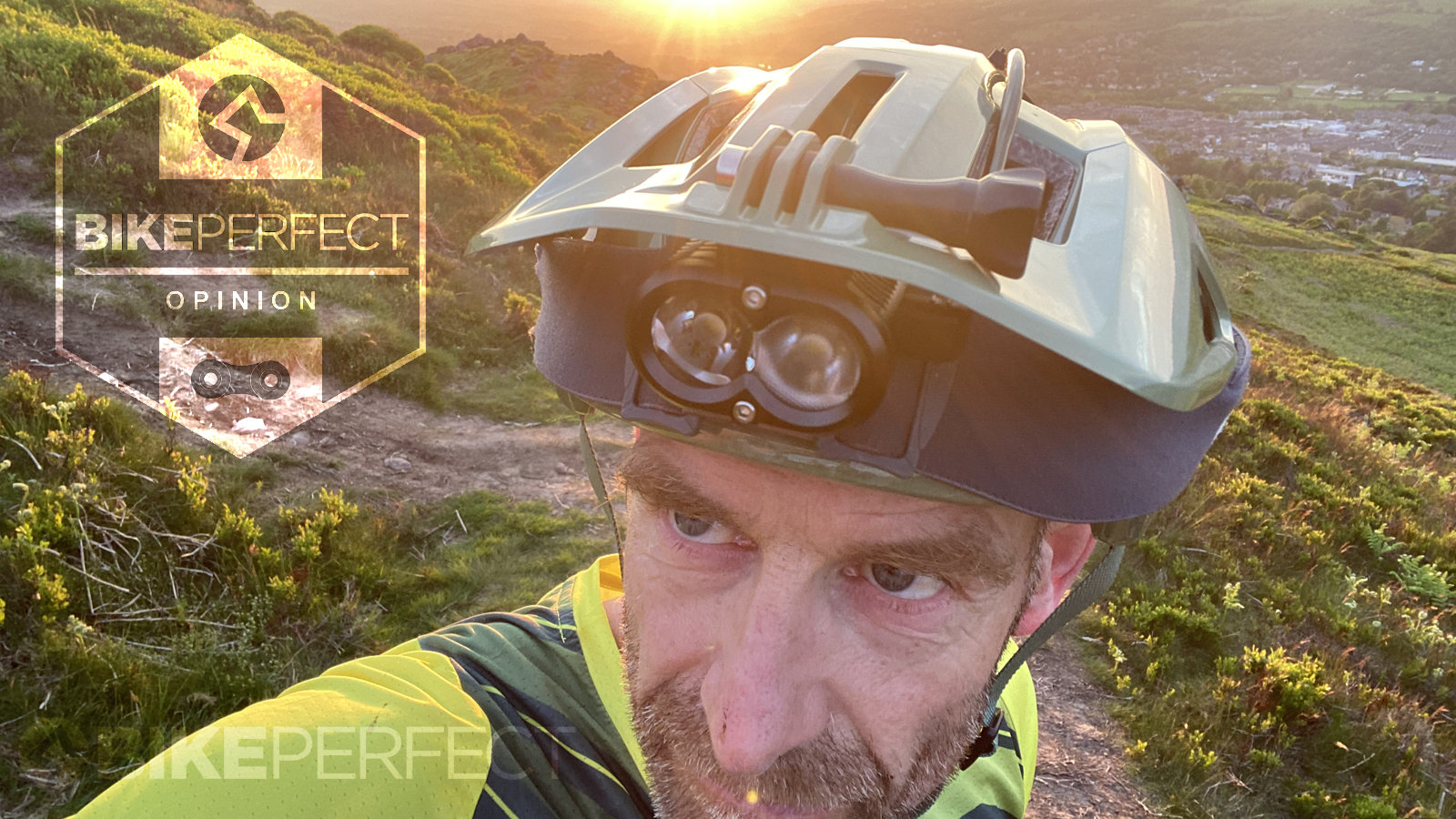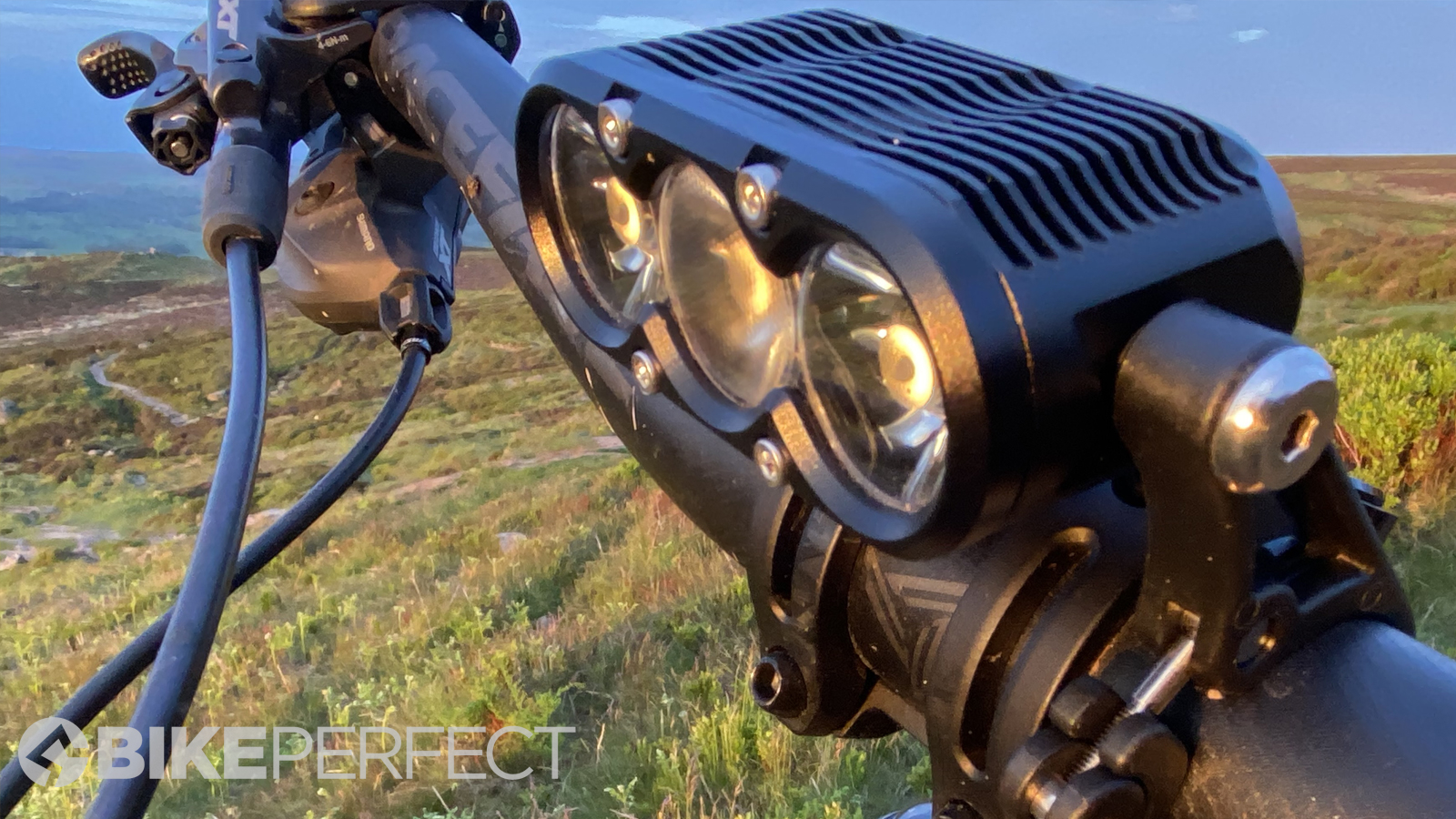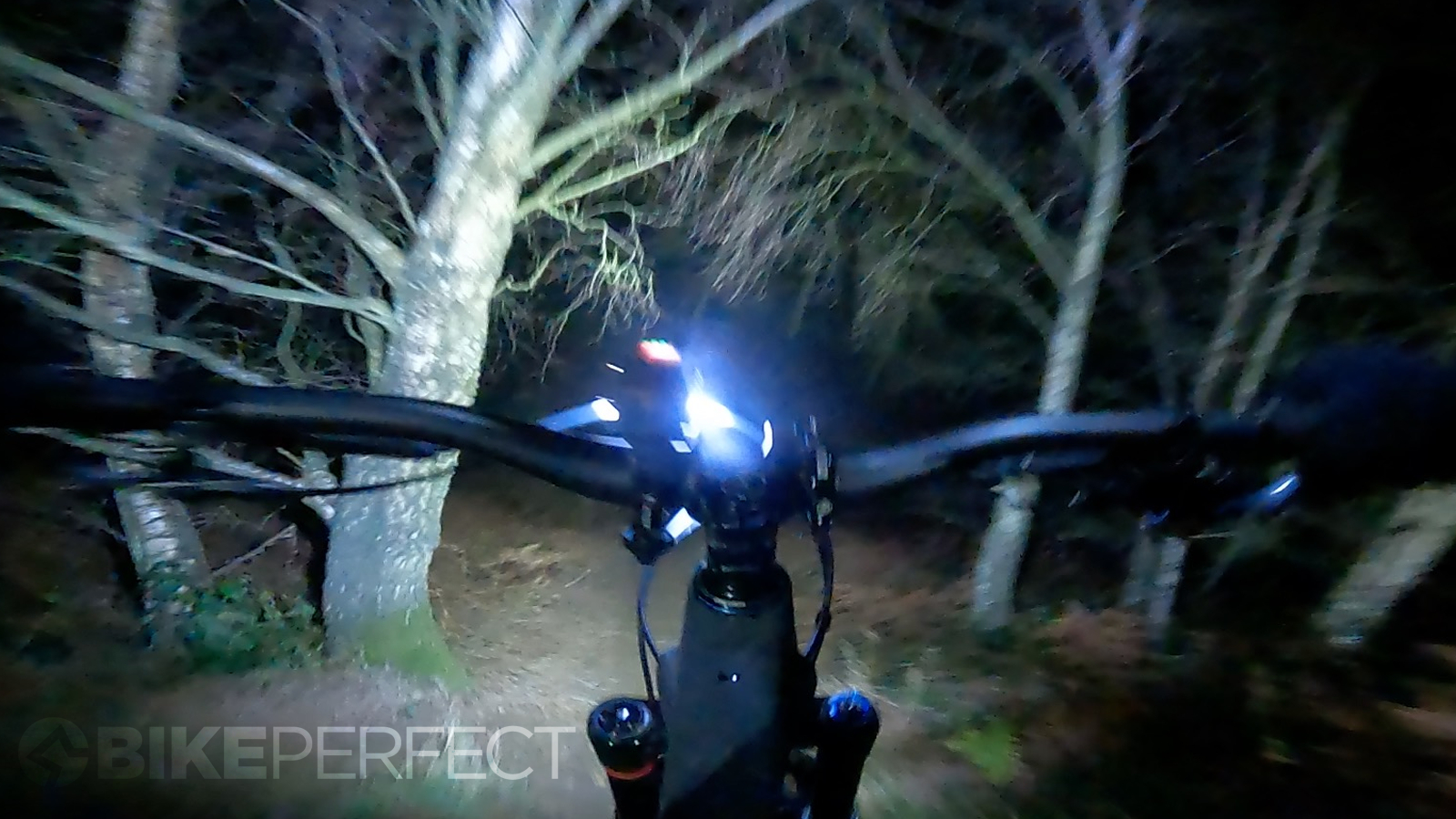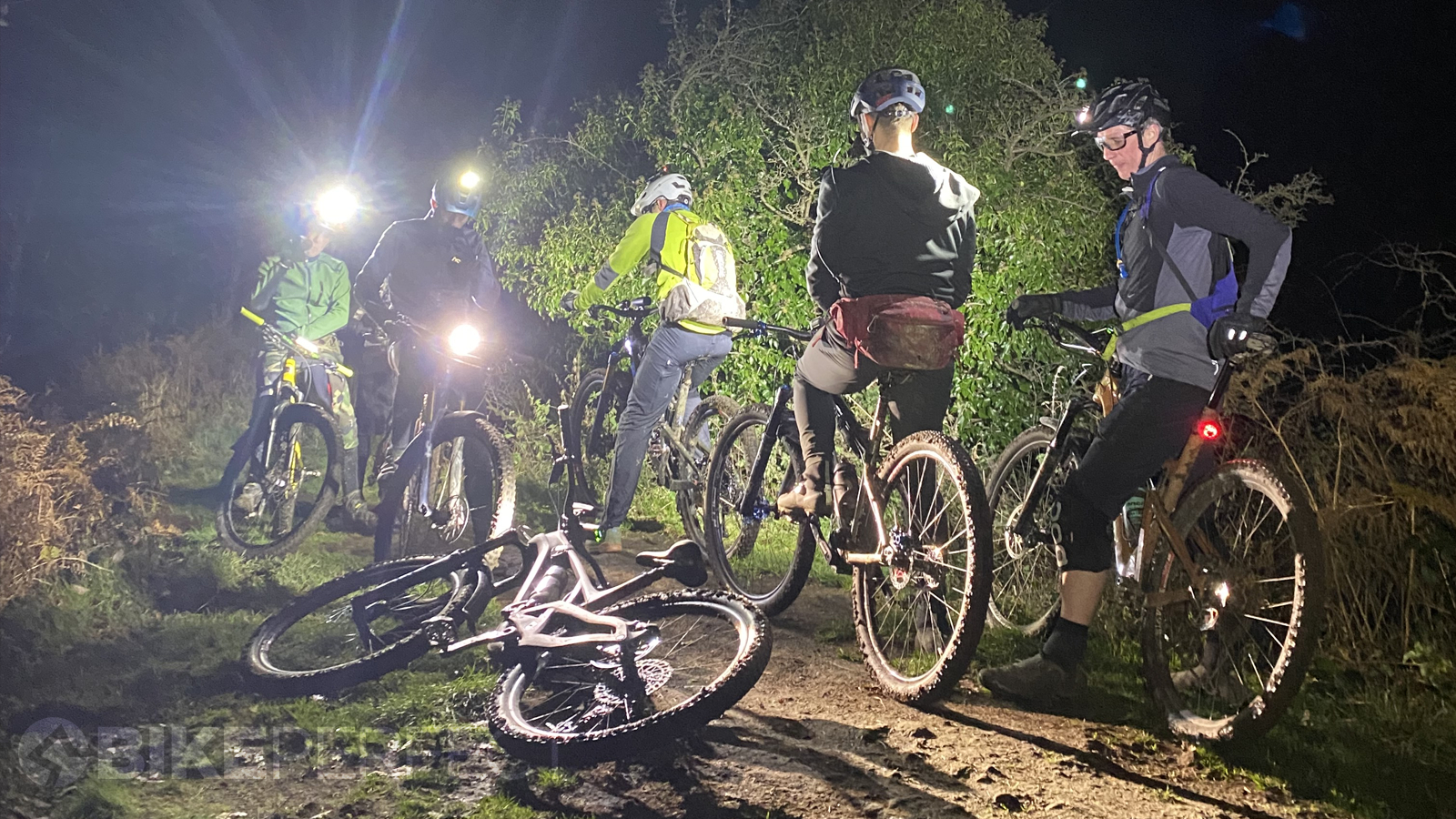Bespoken Word: Christmas lights
If Guy Kesteven had to give every mountain biker a present this Christmas, it would definitely be a half decent set of lights

To be honest I didn’t even realize not riding at night was a thing, because I’ve been fumbling into the darkness off-road on a bike for almost as long as I’ve been riding. Several different conversations this year have made me realize that this is actually a bewildering rarity though, despite living somewhere that’s darker more than it's light for a lot of the year.
For a start, I was interviewed for the Downtime MTB Podcast this summer and they always have a “what product would you recommend for £150?” question at the end. My immediate answer was “Decent bike lights” but apparently I was the first of several hundred interviewees to even mention how awesome night riding is. Then I had a chat with my mate Jim who’s part of a small, progressive local riding crew and he was saying how much he was missing after-work ride sessions. Yet again I told him he and his mates should just grab a bunch of test lights and try it but he not only confessed that he’d never done a proper night ride, but that he thought it wouldn’t work because they tend to just session stuff in the woods, not do a loop ride.
I shook my head about the idiocy of youth and got on with my week, but then two more of Jim’s crew posted a baleful shot of an after-work summer ride saying how much they were missing their after-work fun. I’d already resolved to grab a bag of test lights and herd these curiously night-phobic youths out onto the hill to show them what they’re missing, when a member of another local riding group posted a picture of a day ride they’d just done. I jumped online and asked what ground conditions were like, as it might be a good option for tomorrow night’s ride and the response was “Good luck with that. It’s not a route I’d like to do in the dark.”
So what are people not understanding about how much fun night riding is, and why aren’t they even trying it?

Lit kit
From a kit point of view, there’s never been a better time to give it a go. Even £50 lights now are literally brilliant compared to what we used back in the '80s. At this point there’ll be some sage heads nodding wry smiles about ‘Wonder Lights’ the coveted red-bodied ‘Ever Ready’ with its 1.5V halogen bulb or the all-conquering Petzl climber's head torch at this point. Or even worse, the homemade setups bodged together with a car battery (often on a rear rack) some plastic plumbing fitments for the head unit, wiring from Maplin and a motorbike or car spotlight. I can still remember the plaintive cries of “no, I’m sure it’ll work now” as we finally got bored of waiting and rode off into the dark and left them to learn their lesson. I can also remember how excited we were when the first ‘proper’ lights from specialists like BLT and Nightsun started appearing, and we could suddenly almost see beyond our front tires. Well, they did as long as you’d carefully navigated the ultra temperamental recharge habits of the lead-acid batteries.
I was actually working at the UK distributor for Japanese lights brand Cateye as they shifted from ‘vague haze of yellowy light for a few meters down the trail’ to the (then at least) insane ‘I’ve been abducted by aliens’ blue-white night destruction of its Stadium metal halide light. I also remember laughing at the screams of Mark the warranty bloke as yet another returned one started firing smoke out of the train-shaped (and sized) battery, and he fought to get the office window open so it could be chucked outside before it exploded. We laughed less, having to explain to customers that if the incredibly fragile bulb broke it was £100 to replace. And that was £100 in 1995 when a loaf of sliced bread was about 40p. And not only is illumination the only part of mountain biking that seems to have seen reversed inflation in terms of price for performance, it’s brilliant ride time value too. Or to put it another way, for less than the price of a premium tire, you can now not only ride whenever you want all year round, you can expect your lights to work whenever you need them.

Light fantastic
While early lights were a woeful reliability or ‘recharge memory’ lottery, you don't need the best mountain bike lights to get usable night time performance. Now even a £50 light will use virtually indestructible solid-state LEDs powered by equally robust lithium-ion batteries that recharge fine, whatever level of charge you plug them in at. It’ll probably run for an hour or more at a level that’s just about enough to ride on trails you already know without suddenly finding you’ve hit a log or put your front wheel in a hole. Double the budget to £100 and you’ve got all sorts of choices. 1,000+ lumens is easily enough to ride fast on a trail you sort of know, even if it’s quite techy. Even at this price, you can expect really useful features like battery run time communication, wireless switch or smart mounts. Even direct sell lights are way more reliable these days and less likely to resort to kitchen arson if you leave them charging overnight. And while you can easily spend more and get more powerful, techy, bigger battery lights as your vampiric thirst for after dark action increases, it’s definitely not essential straight away. Not least because - as long as you’re not being shadowed by the following rider with brighter lights - your eyes will rapidly adapt to whatever light you have and you’ll be amazed what detail you can pick up after a while on low power settings. In fact, we regularly ride completely lights off over the local moors when the skies are high and the moon is bright and that’s pretty damn wonderful to be honest.
It is also worth mentioning that modern mountain bikes are a whole lot safer to go charging into the night on. Because all those slack, low, stretched geometry, tougher, grippier tire, dropped seat and sorted suspension advantages are even more apparent when you’re riding more by instinct rather than clear insight.

Riding in a whole new light
And while saying you’ll see local routes you’ve ridden to death ‘in a whole new light’ is clearly a labored pun, it’s also totally true. With all your focus contained in the narrow beam of your light, any peripheral distraction or environment is instantly forgotten, so running down the side of the fence by the sewage works feels as wild and remote as a forest in the middle of nowhere. As dog walkers/ramblers/horse riders, etc. rarely go out at night, it also opens up responsible use of trails that are normally way too busy to consider riding during the day.
The actual experience of riding at night is awesome too. Charging through the darkness naturally fires up all your flight or fight ‘Spidey senses’ and hypes up the howling, baying ‘running with the pack’ vulpine vibe in a way that normal daylight riding can’t touch. You’ll be amazed how different trails look and feel with peripheral locators removed and how easily you can be totally, comically lost even if you’ve only gone the wrong side of one tree. With corners and other features jumping out of your peripheral at the last minute you’ll learn to stay a lot looser and react a lot more quickly. If you’ve set your lights up to look far enough down the trail, you won’t even be able to see what’s under your tires and making you slip, so you’ll just have to react instinctively to stay upright. And if you’ve not got a helmet light the whole ‘is that a big hole or just a shallow shadow’ gamble can make even the most boring dog walking trail a proper pulse raiser. Night riding also trains you to use your other senses more, such as listening for changes in traction or even smelling what’s likely to be a sticky bog before you even sink into it.

Spotlight sessions
And if you’re a session bandit then night riding actually works better for you than anyone else. For a start, any ride will need to stop more frequently to check nobody has been left behind in the dark. So throwing in a couple of repeats or short laps while you regroup makes perfect sense, and even if your personal lights are a bit feeble you can help each other by lighting up features as you roll in. Riding in a big group is also a lot safer than heading out solo at a time when it might be hours before your wreckage is found by an early morning dog walker.
And as much as I’m an after-dark evangelist there are a few more things you need to think about when riding off-road at night. Obviously, however good your lights are, they’re not always pointing in the right direction and your eyes might not translate what they’re illuminating as well or as quickly, so night riding is inherently riskier. You’re also out riding when it’s likely to be colder, and help will be slower to arrive so don’t push your limits and take spare clothes and survival blankets in case you’re out on the hill for longer than expected. Make sure your bike is in good working order too, because trying to repair things at night is a whole lot harder, especially if something small and vital rolls off into the dark. Take a spare light - even a crap one - as well because fumbling out with a feeble glow is better than nothing and it’ll also work as a beacon if someone is looking for you. Oh, and let someone know where you’re going either with a likely route on a note left somewhere prominent or by switching on the locator on your phone/helmet/GPS.
Be sure to let whoever is watching that blip know where you’re finishing the ride though, so they don’t call emergency services thinking you’ve crashed when all you’re doing is babbling like hysterical kids at a theme park about how brilliant blasting through woods and down trails at night has been. Because if you’re reading this having never tried proper after-dark adventures, I guarantee if you give it a go you’ll be totally stoked and buzzing to get out into the night again as soon as possible.

Guy Kesteven has been working on Bike Perfect since its launch in 2019. He started writing and testing for bike mags in 1996. Since then he’s written several million words about several thousand test bikes and a ridiculous amount of riding gear. He’s also penned a handful of bike-related books and he reviews MTBs over on YouTube.
Current rides: Cervelo ZFS-5, Specialized Chisel, custom Nicolai enduro tandem, Landescape/Swallow custom gravel tandem
Height: 180cm
Weight: 69kg
